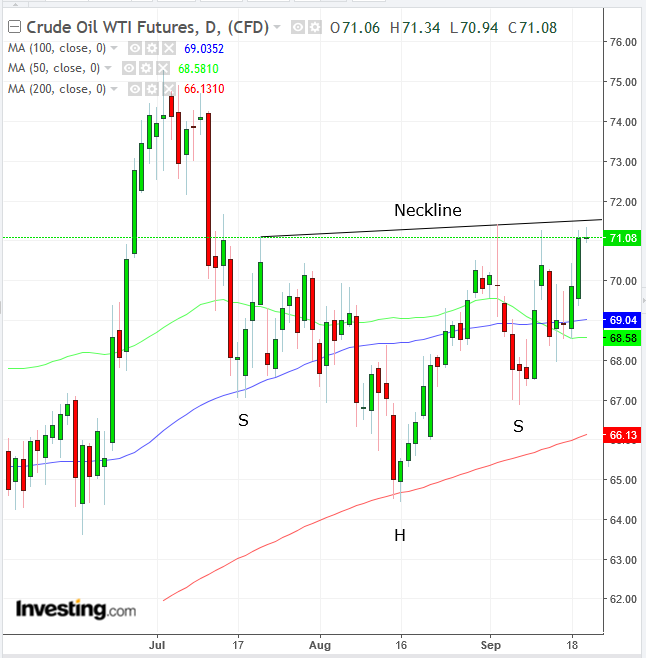- Dow reaches just 0.6 below its record high, as US tariffs on China considered mild
- Dollar maintains losses after failed trade talks with Canada
- Oil boosted on weak dollar and falling inventories
Key Events
European stocks crawled higher this morning, while US equity futures for the S&P 500, Dow and NASDAQ 100 meandered, as traders await signals on market direction, amid the uncertainties of global trade. Treasury yields for the 10-year note remain above 3 percent and the dollar has been pressured to its lowest levels since August.
The pan-European STOXX 600 climbed for the fifth straight day, boosted by a rally of auto manufacturer shares, as the recent round of 10 percent US tariffs on Chinese goods seemed mild. As well, optimism was buoyed by China announcing earlier this morning that it plans to lower average taxes levied at imports from the majority of its trading partners.
From a technical perspective the European benchmark is nearing the top of a falling channel, after the 50 DMA crossed below the 200 DMA earlier in the month, a bearish signal. On the other hand, both the MACD and RSI provide bullish signals. This mismatch of indicators clearly illustrates the uncertainty pervading the current market dynamic.
Global Financial Affairs
Earlier, during the Asian session, South Korea’s KOSPI advanced 0.65 percent, outperforming the region. Investor sentiment was lifted by the summit meeting of the two Koreas. However, the remainder of local benchmarks, including Japan's Nikkei, Hong Kong's Hang Seng and China's Shanghai Composite were little changed.
During yesterday's US session, the Dow Jones Industrial Average advanced 0.61 percent, outperforming the other major US indices. Shares of Caterpillar (NYSE:CAT) and Boeing (NYSE:BA) pushed theh index higher after China announced it won’t devalue its currency.

After completing a bullish flag last week, the Dow yesterday hit just 0.6 percent below its late-January peak. The pattern’s implied target coincides with the record level, demonstrating that different perspectives meet at the same price level.
The NASDAQ was little changed, falling 0.08 percent and the Russell 2000 declined 0.47 percent, as investors rotated out of domestic stocks and into multinationals, a result of the relief at the mild tariffs.
Thus far, investors have repeatedly indicated they are comfortable with the trade dispute at its current levels. They appear to persist in viewing the activity as nothing more than high-stakes negotiating tactics.
The fact that stocks continue climbing in the face of rising yields is an additional signal that investors remain bullish on stocks, since they haven't yet cashed out in order to rotate profits into 3 percent plus yields. Unless the level of global risk intensifies, or volatility picks up, it appears stocks have a green light to keep climbing.

The dollar fell against most major currencies after a report said the US and Canada are unlikely to reach a deal this week on NAFTA. Technically, the USD is about to fall to its lowest level since late July, after it fell below the 100 DMA (blue). As well, it has formed a second trough, establishing a downtrend.

West Texas crude maintained yesterday’s gains, staying above $71 a barrel, even on declining stockpiles and a weaker dollar. Technically, if the price continues to rise to $72, it would complete a H&S bottom reversal.
Brent has been flirting with the $80 level for the past week. Is this a sustainable price for the European crude oil benchmark? There are arguments to be made for and against.
Up Ahead
- August data on US existing home sales, released on Thursday, will show whether purchases declined for a fifth straight month, which would be the longest negative streak since 2013-14.
- The Organization of Petroleum Exporting Countries and its allies meet in Algiers this weekend.
Market Moves
All prices correct at time of publication
Stocks
- The Stoxx Europe 600 Index increased 0.4 percent.
- Futures on the S&P 500 Index climbed less than 0.09 percent.
- The U.K.’s FTSE 100 gained about 0.2 percent.
- Germany’s DAX rose less than 0.05 percent to the highest in more than two weeks.
- The MSCI Emerging Markets Index jumped 1.11 percent to the highest in more than two weeks.
- The MSCI Asia Pacific Index jumped 1.32 percent to the highest in almost three weeks.
Currencies
- The Dollar Spot Index decreased 0.23 percent.
- The euro gained 0.26 percent to $1.1703.
- The British pound increased 0.51 percent to $1.3211, the strongest in eight weeks.
- The Japanese yen rose more than 0.1 percent to 112.20 per dollar.
Bonds
- The yield on 10-year Treasuries climbed less than one basis point to 3.06 percent, the highest in more than four months.
- Germany’s 10-year yield decreased less than one basis point to 0.485 percent, the first retreat in more than a week.
- Britain’s 10-year yield declined one basis point to 1.602 percent, the first retreat in more than a week.
- Italy’s 10-year yield climbed less than one basis point to 2.856 percent.
Commodities
- West Texas Intermediate crude increased 0.8 percent to $71.69 a barrel, the highest in almost four years.
- Gold fell less than 0.05 percent to $1,203.72 an ounce.
